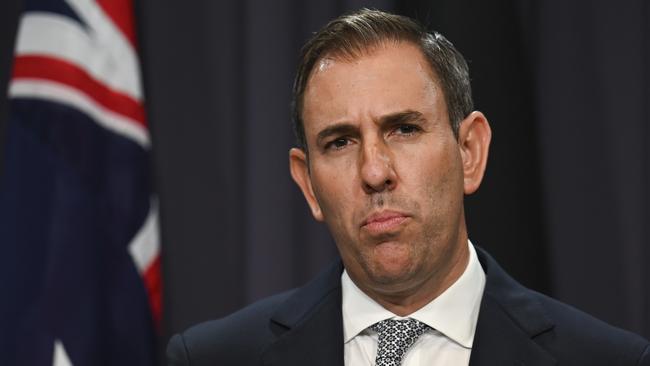Jim Chalmers flags treasurer’s RBA veto power could stay
Jim Chalmers has signalled he will reconsider plans to scrap the treasurer’s veto over central bank interest rates decisions, after support in parliament for the reform grew more tenuous.

Jim Chalmers has signalled he will reconsider plans to scrap the treasurer’s veto over central bank interest rates decisions, after support in parliament for the reform grew more tenuous, with the Greens vowing to oppose it and the Coalition holding approval back.
The political stoush came as former Reserve Bank boss Bernie Fraser joined Peter Costello and others in resisting the change.
Mr Fraser said scrapping the never-before-used power would remove a “safety valve” that actually bolstered the bank’s independence.
Another former RBA governor, Ian Macfarlane, at a Senate committee hearing on Thursday also backed maintaining the status quo.
Labor’s review into the bank recommended several changes that would require updating the RBA Act, including an amendment to create a new specialist monetary policy setting board that the Treasurer hopes to have in place by the middle of this year.
Proponents of the change to remove the veto power in section 11 of the act have argued that the treasurer’s power to overrule the RBA decisions has never been used in practice, and removing it would “future-proof” the central bank’s independence.
As the Greens announced they would push amended legislation that would keep section 11, opposition Treasury spokesman Angus Taylor said “we have always said we are prepared to work with the government to improve the legislation … With regards to section 11, the Coalition will consider its final position through party processes once the committee delivers its final report.”
Dr Chalmers said “the RBA review and the government’s response is all about reinforcing the independence of the Reserve Bank. It’s disappointing but not surprising to see the Liberals team up with the Greens to play politics with the independent RBA.
“We will carefully consider this development and respond in due course,” he said.
Mr Fraser, who through the 1980s and ’90s served terms as Treasury secretary and governor during the Hawke and Keating governments, said “the government of the day is entitled to challenge – in a reasonable way – the RBA’s decisions when it believes those decisions are seriously out of keeping with the RBA charter”.
Section 11 of the central bank act “provides a legislative path for governments to pursue such challenges in the parliament,” Mr Fraser said.
The veto power “does not stop politicians (and others) from calling for government interventions in the bank’s decision-making and in the tenure of its governors, as we have heard in Australia and elsewhere in recent months”.
“It does provide a fair and reasonable process – indeed, a safety valve – for deliberation if required,” Mr Fraser said.
RBA governor Michele Bullock said she was “agnostic” about the future of the veto power.
She said the RBA did not lobby for the proposed change and she believed the central bank had sufficient independence to do its job.
“I’m agnostic on this issue, and what the government decides, I think we can work with,” Ms Bullock said.
Mr Costello said the debate around section 11 came down to “a question of sovereignty”.
“Frankly, I think that it’d be better to have it (the veto power) there than to have some new power legislated in some extreme circumstance,” he said.
Ms Bullock also called for continuity of membership when transitioning to the proposed separate monetary policy board.
“Monetary policy setting … you don’t just set it a meeting and then start with a blank sheet of paper the next meeting,” she said.
“It’s a continuous decision. It’s a continual discussion.
“And I think in those circumstances, it’s really important that if we go into this new world that we have continuity of membership to provide that,” she added.
Ms Bullock said Dr Chalmers “has assured me that he understands and that he will be looking to provide continuity for us”.




To join the conversation, please log in. Don't have an account? Register
Join the conversation, you are commenting as Logout